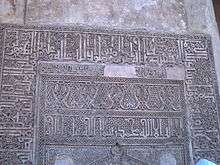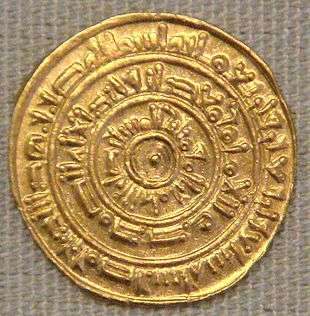Al-Mustansir Billah
Abū Tamīm Ma‘ad al-Mustanṣir bi-llāh (Arabic: أبو تميم معد المستنصر بالله; July 5, 1029 – January 10, 1094) was the eighth caliph of the Fatimid Caliphate from 1036 until 1094.[1] He was the longest reigning Muslim ruler.[2]
Biography
He was born in Cairo on 16th Jumada II, 420 AH and at the age of only eight months was declared to succeed his father. His name was Ma'd Abu Tamim, surnamed al-Mustansir bil-Lah ("The Asker Of Victory From God"). He ascended to the Fatimid Caliphate throne on 15th Shaban, 427/June 13, 1036 at the age of 6. During the early years of his Caliphate, the state affairs were administered by his mother. His period of Caliphate lasted for 60 years, the longest of all the caliphs, either in Egypt or elsewhere in Islamic states. However, Fatimid power was confined to Egypt due to conquests of Seljuks in Levant and Yemen and Normans in Sicily and Malta.
He has constructed a special qibla at one of a pillar in the Mosque of Ibn Tulun. At the qibla top his name is clearly engraved along with Shahada recited by public in Fatimid era specifically the phrase 'Ali-un-Vali-ul-lah'.
Al-Mustansir's court
Prominent Dai/Vizir of his era are as under:
- Ali bin Ahmad Jarjarai, vizier (d. 1045)
- Badr al-Jamali, vizier (d. 1094)
- Mu'ayyad fi'l-Din al-Shirazi, chief missionary (dā‘i al-dū‘at) from 1059 to 1078[3]
Moulai Abadullah and Syedi Nuruddin were two Indian who visited Imam Al-Mustansir Billah, Egypt. He joined the Ismaili faith under Fatimid Dai Mu'ayyad fi'l-Din al-Shirazi, and went to India to propagate the faith.[4]
Architecture

Prominent architecture of his era are as under:
Famine
Between 457/1065 and 464/1072, famine degraded conditions in Egypt from bad to worse. Meanwhile, in 454/1062 and again in 459/1067, the struggle between the Turkish and Sudanese soldiery deteriorated into open warfare, ending in a victory for the Turks.
During this same period, Berber nomadic tribes from lower Egypt deliberately aggravated the distress by ravaging the countryside, destroying the embankments and canals of the Nile. The ten thousand animals that al-Mustansir's stables once held reportedly deteriorated to the point where only three thin horses were left; it is said that eventually al-Mustansir alone possessed a horse, and that when he rode out, the courtiers followed on foot, having no beast to carry them; it is also said that his escort once fainted from hunger as it accompanied him through the streets. As long as the calamity lasted, the condition of the country continued to decline. The protracted famine was followed inevitably by plague; whole districts were absolutely denuded of population and house after house lay empty.
Turkish mercenaries
Concurrently, the Turkish mercenaries had drained the treasury; many of the works of art and valuables of all sorts in the palace were sold to satisfy their demands---often they themselves were the purchasers, at merely nominal prices, and resold the articles thus gained at a profit. Emeralds valued at 300,000 dinars were bought by one Turkish general for 500 dinars, and in one fortnight of the year 460/1068 articles to the value of 30,000,000 dinars were sold off to provide pay for the Turks. The precious library, which had been rendered available to the public and was one of the attractions for many who visited Cairo, was scattered; the books were torn up, thrown away, or used to light fires. At length, the Turks began fighting amongst themselves. Nasir al-Dawla ibn Hamdan, the general of the Turks, had invested the city, which was defended by the rival faction of the Turkish guard; after burning part of Fustat and defeating the defenders, he entered as conqueror. When he reached the palace, he found al-Mustansir lodged in rooms which had been stripped bare, waited on by only three slaves, and subsisting on two loaves which were sent him daily by the daughters of Ibn Babshand, the grammarian.
The victorious Turks dominated Cairo, held the successive viziers in subjection, treated al-Mustansir with contempt, and used their power to deplete the treasury by enhancing their pay to nearly twenty times its former figure. Nasir al-Dawla became so overbearing and tyrannical in his conduct that he provoked even his own followers, and so at length he was assassinated in 466/1074. Unfortunately, this left the city in a worse condition than ever, for it was now at the mercy of the various Turkish factions, who behaved no better than brigands. Conditions in Egypt continued to deteriorate, and unabated violence raged in the streets and countryside alike.
Gallery
 Al-Mustansir's mihrab at the Ibn Tulun mosque, Cairo
Al-Mustansir's mihrab at the Ibn Tulun mosque, Cairo Stone inscription from al-Mustansir's time near al-Mustansir's mihrab
Stone inscription from al-Mustansir's time near al-Mustansir's mihrab Detail of al-Mustansir's mihrab
Detail of al-Mustansir's mihrab Al-Mustansir's name engraved on the mihrab
Al-Mustansir's name engraved on the mihrab
See also
References
- ↑ "Al-Mustanṣir" Encyclopædia Britannica Retrieved 24 January 2015
- ↑ "Al-Mustanṣir" Encyclopædia Britannica Retrieved 31 January 2015
- ↑ Klemm, Verena (2004). "MOʾAYYAD FI'L-DIN ŠIRĀZI". Encyclopaedia Iranica.
- ↑ 12.0 The Fatimid Da'i Al-Mu'ayyad: His Life , by: Dr. Abbas Hamdani, University of Wisconsin, Milwaukee (U.S.A.): ..In this village there were two .men who acquired knowledge, then proceeded from India, in the time of al-Mustansir, to Egypt and joined the lsma'ili faith at the bidding of Sayyidna al-Mu'ayyad from whom they acquired much knowledge. Their names were (Ba)Lam Nath(known as Moulai Abadullah) and Rup Nath (later called Mawla'i Nurad-Din). Both of them returned from Egypt to their native village...."
Al-Mustansir Billah Born: July 5, 1029 Died: January 10, 1094 | ||
| Regnal titles | ||
|---|---|---|
| Preceded by az-Zahir |
Caliph of the Fatimid Caliphate 1036-1094 |
Succeeded by al-Musta'li |

